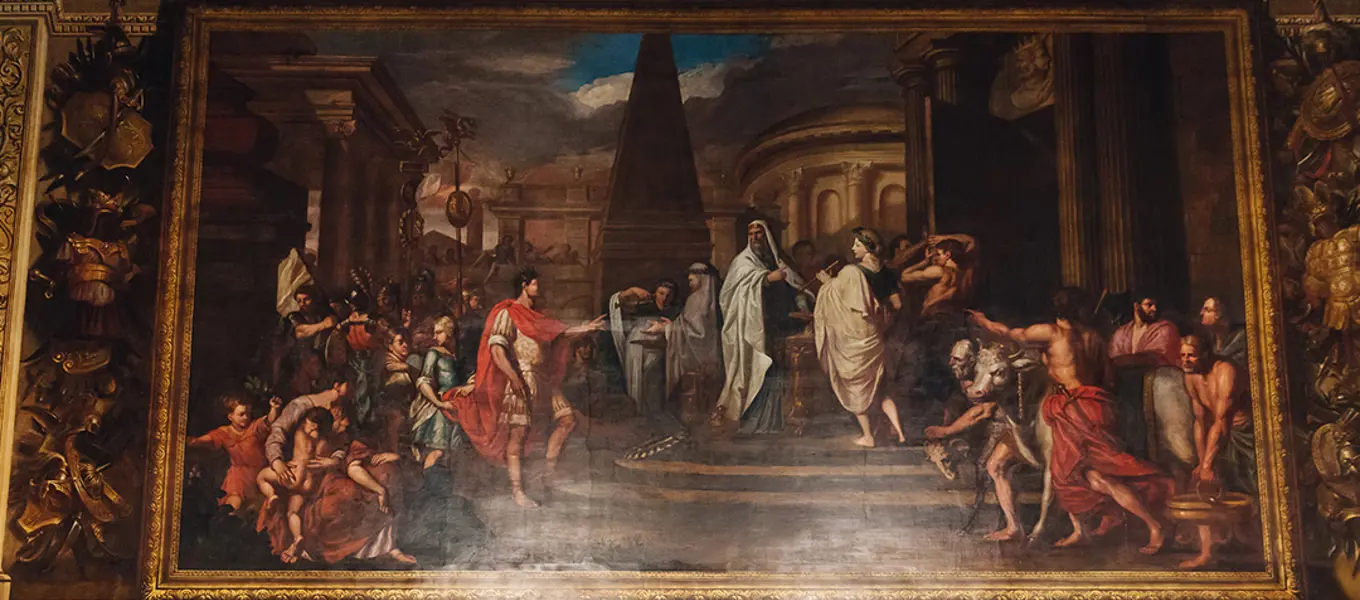Occupying the same location as the Elizabethan Great Hall built for Bess of Hardwick and Sir William Cavendish in the 1550s, the Painted Hall is the largest and grandest room in the original house. It has undergone three major changes in its history, the most striking element being the reconstruction of the staircase rising to the first floor, which has been rebuilt twice.
Dominating the room is the painted decoration which gives rise to its name, the only part of the interior which survives from its creation in 1687-1694. The paintings were painted by Louis Laguerre (1663-1721) and depict scenes from the life of the Roman General Julius Caesar (100-44 BC). The Roman general’s victories, authority, and eventual downfall provided a striking political parallel for the era.
The long east wall, pictured below, shows him offering sacrifice at the Temple, flanked by oval scenes, painted in imitation of carved stone, which illustrate his journeys across the Rubicon River and the English Channel.

The 1st Duke deliberately chose the subject of Caesar for the decoration in an attempt to flatter the new protestant monarch, William III (1650-1702). A group of seven English aristocrats, including William Cavendish, then 4th Earl of Devonshire, had invited Dutch born William III to take the throne with his English wife Mary II in 1688. In 1694 William and Mary rewarded the 4th Earl for his support by making him 1st Duke of Devonshire.
Perhaps as a reminder to William not to exceed his legitimate power, the scene on the north wall above the entrance to the room shows the assassination of Caesar by the members of the Senate. Between the windows the walls are painted with large arrangements of arms and armour in the style of Roman trophies, and the openings at the top of the staircase recall the architectural form of a Roman triumphal arch, complementing the Roman theme of the interior.
Image 1: the North Wall. Image 2: the staircase with the archway, and catwalk to the right.
The present staircase, and the catwalk gallery below the windows, was created in 1912 for the 9th Duke and Duchess Evelyn. The balustrades are copies of the 17th century balustrade on the Great Stairs above, and were made by the Arts and Crafts Workshop of the Bromsgrove Guild.
The 1912 staircase replaced one built for the 6th Duke in the 1820s to designs by Sir Jeffry Wyatville. Duchess Evelyn commented that it “…had a balustrade that would have been a disgrace to any London area.” The 6th Duke himself noted that the former staircase, built in 1691 with two curved flights enriched with carved alabaster, marble and the local quartz mineral Blue John, was “much handsomer”.
Image 1: the Painted Hall circa 1900. Image 2: taken during the rebuilding of the staircase.
In 1936 the ceiling was discovered to be sagging and on the point of collapse. Over the course of two years the floor above was reinforced and the original plaster reattached before all the cracks were filled and the painting restored. In 1996 the ceiling was cleaned and conserved again, and the walls in 2005-2006.
Explore more...
Oak Room
This room was completely changed by the 6th Duke with the wood panelling he bought at an auction.
Chapel
This is the least changed room at Chatsworth, the 1st Duke employed the best artists to realise his designs.
State Drawing Room
The second room of the State Apartment, a suite of rooms intended to host a king.
State Bedchamber
One of the most private rooms in the State Apartment, this room was more lavishly decorated than all the others and features the State Bed.
Old Master Drawings Cabinet
This room was designed to display Old Master Drawings.
North Sketch Gallery
The North Sketch Gallery, created in 2009, showcases contemporary art and ceramics.
Oak Stairs/Leicester Landing
The stairs were created when the 6th Duke added the North Wing. They connected the old part of the house to the new.
Library and Ante Library
There are over 17,000 books in these two rooms. The whole Chatsworth book collection numbers around 40,000 volumes.
Great Dining Room
Built as part of the 6th Duke’s renovation, this room is still used for formal dinners.
Sculpture Gallery
Built by the 6th Duke, the gallery contains one of the foremost early 19th century contemporary collections of sculpture.
History of Chatsworth
Learn about the Devonshires and discover how they shaped the history of the house, garden and collection that we see today.
History of the garden
The garden evolved over nearly 500 years. Discover its history and the people who shaped it.
The Devonshire Collections
Discover highlights from the art, library and archive that make up the Devonshire Collections.
The House
Learn more about what's on in the house.



